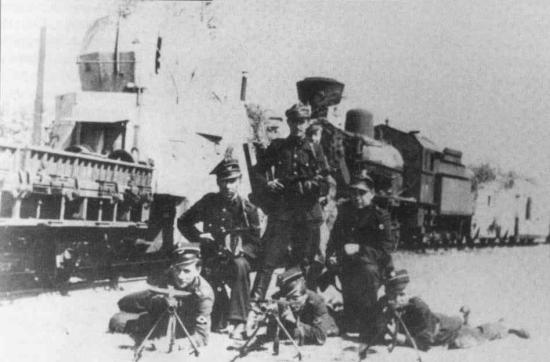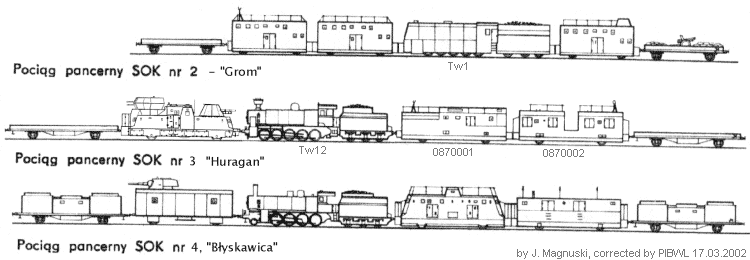|  | |||||
Polish improvised armoured trains of the SOK (Railway Protection Service)
History and organization - Nr. 1 "Szczecin" - Nr 2. "Grom" - Nr. 3 "Huragan" - Nr. 4 "Błyskawica" • Draisines
|  | |||||
History and organization - Nr. 1 "Szczecin" - Nr 2. "Grom" - Nr. 3 "Huragan" - Nr. 4 "Błyskawica" • Draisines
The improvised armoured trains of the Railway Protection Service (Służba Ochrony Kolei - SOK) are some of most obscure parts of the history of the Polish Armour. Unfortunately, most of the information and data are only approximate ones, because of very scarce sources. The only few available and published photos are of very poor quality. Most of the information below are taken from the pioneering research by Janusz Magnuski, but we have also tried to identify or correct some of the wagons of German origin.
Note: this page was recovered in 2021, however it was created in 2002 and has not been substantially updated since, so it presents a state of knowledge from 1980s. There have been however no new publications on this subject known to us published so far.
After the World War II had ended, the warfare lasted still in south-eastern areas of Poland. Polish units of the Army, Internal Security Corps (KBW) and Citizen Militia (Milicja Obywatelska, MO - the name of Polish Police in 1944-89) were still fighting with Ukrainian nationalist partisans of the UPA - Ukrainian Insurgent Army. The UPA partisans were murdering and terrorizing Polish inhabitants in these areas and fighting against Polish authorities, finding some support in inhabitants of Ukrainian nationality, but also punishing non-supporters or those, who agreed to relocate to Ukraine. At that time, the masses of people of Ukrainian nationality were being moved to Soviet Ukraine, while people of Polish nationality were being moved from Soviet area. Among others, UPA partisans were attacking the railways, stations, bridges and transports of people. In order to protect the railways, the new armed security formation was created: Służba Ochrony Kolei (SOK) - the Railway Protection Service, subordinated to the Ministry of Internal Affairs, not the Army (Ministry of Defence). To carry out its duties more efficiently, in the autumn of 1945 the SOK HQ started forming of improvised armoured trains, with the Army's help. They were meant to patrol the tracks, and protect trains in dangerous areas. Their crews were formed of volunteers from the SOK, as well as soldiers, officers and NCO's.
However crew enlistment was not a problem, but the completing of the equipment was not so easy. Unfortunately, despite numerous armoured trains took part in the heavy warfare on Polish territory in 1939 and 1944-45, and the Germans even set up armoured trains' training base in Rembertowo near Warsaw, yet not much of armoured rolling stock survived in Poland after the war. Most ex-German armoured wagons and locomotives were immediately carried away by the Soviet Army as a booty. Only few armoured wagons survived, usually damaged or destroyed. After repairs in railway workshops, they were used to create several improvised trains. Several freight wagons were fitted with an improvised cover, like a concrete (returning to the roots, like in the trains of 1918-20...). The forming of new trains took place in Warsaw and Cracov mainly, most of them were sent to the south-east of Poland then.
 |
| Armoured train nr. 2 - the 76.2mm wz.43 gun on a flatcar |
The first armoured train, nr. 1 "Szczecin", was formed probably in the end of 1945. In October 1945 the train nr. 2 was formed, probably bearing the name "Grom" later. A year later, in October 1946, another train nr. 3 "Huragan" went into service, and in December 1946 the last train nr. 4 "Błyskawica" was formed. In 1946-47 years, these trains were known by the numbers mainly, the names were officially given later. In later period the names were used first of all. The armoured trains were re-organized during the service, and their composition was changing. Unfortunately, the information below as for the trains' composition and service is very partial and incomplete.
In early 1947 the existing four armoured trains formed the SOK armoured train unit (dywizjon pociagów pancernych SOK), commanded by Cpt. Marian Jarosz. The unit's base was a small railway station in Zagórz near Sanok town (south-east of Poland). The unit took part in combat against UPA in Bieszczady Mountains. Later the unit received also one or two armoured draisines. In April 1947 the unit was subordinated to Gen. Stefan Mossor, a commander of a newly-created Operational Group "Wisła" (Vistula). The armoured train unit, along with Group's units, took part in the Operation "Wisła", aimed to displace all the inhabitants from Bieszczady Mountains and their neighbourhood to other parts of Poland, in order to cut UPA partisans off of supplies or shelter. It was rough measure which remains controversial, but it put an end to the terror of UPA partisans in Poland (in the Soviet Ukraine the fighting with the UPA lasted till the sixties). The Operational Group was disbanded on 31 July 1947, the armoured train unit was disbanded as well. Two armoured trains (probably Nos. 1 and 2) were moved to the Military District V HQ (DOK V - Cracov), and the other two (probably Nos. 3 and 4) were moved to the Military District VII HQ (DOK VII - Lublin). These Districts carried out further combat with the remainder of UPA, until 1948. The armoured trains were probably used in this further combat as well. Some of these armoured trains existed in SOK up to late 1940s. Due to the lack of serious threats of the railway transport, they were used mainly for training of the SOK guards. From time to time, however, they were used in raids against ...the thefts of a coal on stations. Most likely the armoured trains of the SOK were disbanded in 1950s.
This improvised armoured train was formed as the first one, probably at the end of 1945. Most crew was completed of the SOK guards from Szczecin (Stettin) - hence eventual name of the train. The train was formed in Jarosław near Przemyśl, under direction of SOK district chief T. Kułak. Initially, it was a wide gauge train (1524 mm, used in Russia). The train was operating on wide gauge tracks in the area of Medyka (on Polish-Soviet border) - Lubaczow - Rawa Ruska. Due to a reconstruction of the railways in Poland, the train was later converted to a standard gauge of 1435 mm (most probably the locomotive was changed).
In March 1946 the train was taken over by the crew formed in Warsaw, commanded by 2nd Lt. J. Steinbock. In November its crew went to the railway workshops in Ostrow Wielkopolski to take over the new train (nr. 4 "Błyskawica"). The old train nr. 1, with a part of the crew, was handed over to Cpt. A. Wierzbicki.
There is no information as for the later composition, but it must have changed.
The armoured train nr. 2 was formed in October 1945 in Warsaw. Soon after forming it was moved to Sanok and subordinated to the 8th Infantry Division. During the following months it cooperated with this division. The train was operating mainly on lines: Sanok - Łupków and Sanok - Ustianowa. It took part in several skirmishes with UPA partisans, among others in Olszanica, Stefkowa, Komańcza and Osłanica stations. The first commander was Lt. Szumowski, the second: 2nd Lt. Marian Jarosz, the third: Lt. E. Tomalak. Most probably this train bore the name "Grom" (the Thunder) later.

 it is possible, that armoured wagon nr 0870026 (Polish number) was used in this train as well. It was a four-axle artillery wagon of BP-44 standard, built by the Germans using the captured Soviet wagon. It might have belonged to armoured train Panzerzug 25, destroyed on 13 January 1945 near Kielce.
it is possible, that armoured wagon nr 0870026 (Polish number) was used in this train as well. It was a four-axle artillery wagon of BP-44 standard, built by the Germans using the captured Soviet wagon. It might have belonged to armoured train Panzerzug 25, destroyed on 13 January 1945 near Kielce. |
| Poor photo of armoured train nr. 3 - from the left: a flatcar, an armoured wagon with Wirbelwind turret, a locomotive series Tw12 and two armoured wagons. The soldiers are armed with 7.62mm DP LMGs. |
Armoured train nr. 3 was created in October 1946. Its commander was Lt. Władysław Indyk. In 1947, like other trains, it was based in Zagórz and used in combat against UPA. In 1948 the train was in the SOK Officer School in Toruń. The name "Huragan" means 'the Hurricane'.
 It was a German late-war variation of a typical artillery and anti-aircraft wagon (Artillerie und Flakwagen) of German construction, type BP-42 or BP-44. Typical wagons of this kind were armed with a quadruple 20mm AA gun Flakvierling-38 with a protective shield, while this one is fitted with a turret of Wirbelwind self-propelled AA gun, armed with the same quadruple Flakvierling-38 gun. Such wagon was used in the German PZ 65 train, possily also in others. Turret sides were armoured with 10 mm armour, the top was open.
It was a German late-war variation of a typical artillery and anti-aircraft wagon (Artillerie und Flakwagen) of German construction, type BP-42 or BP-44. Typical wagons of this kind were armed with a quadruple 20mm AA gun Flakvierling-38 with a protective shield, while this one is fitted with a turret of Wirbelwind self-propelled AA gun, armed with the same quadruple Flakvierling-38 gun. Such wagon was used in the German PZ 65 train, possily also in others. Turret sides were armoured with 10 mm armour, the top was open.  |
| Armoured train nr. 4 - ex-German command wagon. |
The train was formed in December 1946 in Cracov. It utilized ex-German rolling stock repaired in railway workshops in Ostrow Wielkopolski. The commander was Lt. J. Steinbock, then Lt. C. Paczosa. The crew consisted partially of nr. 1 train's crew. Until June 1947 the train nr. 4 stationed at Zagórz near Sanok. After the combat with UPA had eneded, it was moved to Zawada near Zamość. It operated on lines: Zawada - Zwierzyniec - Bełżec and Zawada - Hrubieszów. The name "Błyskawica" means 'the Lightning'.
 armoured infantry wagon, 2-axle, ex-German. It was a typical command wagon (Kommandowagen) of German construction, type BP-42/44. The wagon had rifle ports in the sides. The wagon in Polish service retained rail aerial on a roof, but it is not known, if it still had its original German radio - it might have been fitted with Soviet radio instead.
armoured infantry wagon, 2-axle, ex-German. It was a typical command wagon (Kommandowagen) of German construction, type BP-42/44. The wagon had rifle ports in the sides. The wagon in Polish service retained rail aerial on a roof, but it is not known, if it still had its original German radio - it might have been fitted with Soviet radio instead.See armoured draisine of SOK here.

A sketch by J. Magnuski, showing presumable look of Polish improvised armoured trains of SOK (Railway Protection Service). The trains are in a corrected order (in the book the lower two were misplaced). The wagon of train nr.3 has been corrected by the PIBWL.
Sources:
1. Janusz Magnuski, "Wozy bojowe LWP 1943-1983"; Wydawnictwo MON, Warsaw 1985
Update history:
12. 02. 2021 - page recovered, modernized, small ammendments
2002 - page created.
[ Main page ] [ Polish armour / Polish armoured trains ] [ Polish armoured units ] [ Steel Panthers page ]
You can mail me with any questions or comments.
You can mail me with any questions or comments. Corrections and photos are welcome!
All photos and pictures remain the property of their owners, unless they are public domain. They are published in non-commercial educational and research purpose.
Text copyright to Michal Derela © 2002-2021.